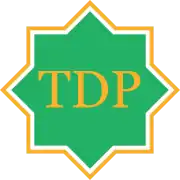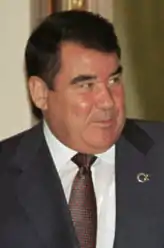Democratic Party of Turkmenistan
The Democratic Party of Turkmenistan (Turkmen: Türkmenistanyň Demokratik Partiýasy; Turkmen pronunciation: [tʏɾkmɛnɪθtɑnɯŋ dɛmokɾɑtɪk pɑɾtɪjɑθɯ]; TDP) has been the ruling party of Turkmenistan since 1991.
Democratic Party of Turkmenistan Türkmenistanyň demokratik partiýasy | |
|---|---|
 | |
| Leader | Ata Serdarov |
| Founder | Saparmurat Niyazov |
| Founded | 16 December 1991 |
| Preceded by | Communist Party of Turkmenistan (KPT) |
| Headquarters | Ashgabat |
| Youth wing | Magtymguly Youth Organisation[1] |
| Ideology | Turkmen nationalism Secularism Social conservatism[2][3] Authoritarianism[4][2][3][5] |
| Political position | Big tent |
| Colours | |
| Seats in the Mejlis of Turkmenistan | 55 / 125 |
| Website | |
| tdp | |
The party was led by former Soviet provincial party leader Saparmurat Niyazov from the dissolution of the Soviet Union in the early 1990s until his death in 2006. In 2013, President Gurbanguly Berdimuhamedow suspended his party membership for the duration of his presidency.[6] The current leader is Ata Serdarov.[7]
History
The DPT was created following the dissolution of the Soviet Union as a successor party to the Communist Party of Turkmenistan. The internal structure of the old party was effectively unchanged in the transition, as was the old guard. The DPT has faced limited and sporadic challenges from alternative political parties in the past but have never faced a significant challenge during an election because of the often repressive nature of politics in the country. Opposition parties are usually crushed before they make any significant grounds in public opinion. This has been the case even after the formal legalization of opposition parties in 2010.
Chairmen
| No. | Picture | Name
(Birth–Death) |
Took office | Left office | Notes |
|---|---|---|---|---|---|
| Chairman | |||||
| 1 |  |
Saparmurat Niyazov
(1940-2006) |
16 December 1991 | 21 December 2006 | Died in office |
| 2 | _02.jpg.webp) |
Gurbanguly Berdimuhamedow
(b. 1957) |
21 December 2006 | 18 August 2013 | Acting Chairman until 4 August 2007, resigned on 18 August 2013 |
| 3 |  |
Kasymguly Babaev
(?) |
18 August 2013 | 3 April 2018 | |
| 4 |  |
Ata Serdarov
(b. 1964) |
3 April 2018 | Incumbent | |
Policies
Due to the lack of opposition parties to contest for government, the DPT controls most, if not all, industries of significant revenue directly. Central planning is a key element of party policy and serves as the basis of functionality for government services. The party's ideology of "Turkmen nationalism" was theorized by former party leader Saparmurat Niyazov for the purpose of an authoritarian state ideology in Turkmenistan.[8]
Election results
Turkmenistan elects on the national level a head of state - the president - and a legislature. The Elections in Turkmenistan have been widely criticized for being completely fraudulent and attempting to give an appearance of legitimacy to what is in reality a dictatorship.
Assembly of Turkmenistan
The Assembly is a 50 member legislative body officially led by the President of Turkmenistan. The DPT, not unlike every other facet of political life in Turkmenistan, holds a majority of seats, with accusations that the "multi-party system" established in the early 2010s only consists of parties loyal to the DPT. The last election for the assembly was held in 2013 where the DPT received 47 out of the 125 seats available with a claimed voter turnout of 91.33%.
Electoral history
Presidential elections
| Election | Party candidate | Votes | % | Result |
|---|---|---|---|---|
| 1992 | Saparmurat Niyazov | 1,874,357 | 99.5% | Elected |
| 2007 | Gurbanguly Berdimuhamedow | 2,357,120 | 89.23% | Elected |
| 2012 | 97.14% | Elected | ||
| 2017 | 3,090,610 | 97.69% | Elected |
Mejlis elections
| Election | Party leader | Votes | % | Seats | +/– | Position |
|---|---|---|---|---|---|---|
| 1994 | Saparmurat Niyazov | 2,008,779 | 100% | 50 / 50 |
||
| 1999 | 2,224,537 | 100% | 50 / 50 |
|||
| 2004 | 1,915,000 | 100% | 50 / 50 |
|||
| 2008 | Gurbanguly Berdimuhamedow | 100% | 125 / 125 |
|||
| 2013 | Kasymguly Babaev | 47 / 125 |
||||
| 2018 | 55 / 125 |
See also
References
- "VI Congress of Magtymguly Youth Organization of Turkmenistan in Ashgabat". tdh.gov.tm. Turkmenistan Today, Government of Turkmenistan. Retrieved 22 January 2021.
- Anderson, John (1995). "Authoritarian political development in Central Asia: The case of Turkmenistan". Central Asian Survey. 14 (4): 509–527. doi:10.1080/02634939508400922.
- https://cyberleninka.ru/article/n/political-elite-of-turkmenistan-post-soviet-period
- "Turkmenistan". freedomhouse.org. Freedom House. Retrieved 22 January 2021.
- Al-Bassam, Kareem (1997). The Evolution of Authoritarianism in Turkmenistan. Demokratizatsiya. p. 387,394,400. S2CID 36015864.
- "Turkmen president quits top party". 18 August 2013 – via Japan Times Online.
- "Chairman of Turkmenistan's Democratic Party elected". Trend News Agency. 3 April 2018.
- "European Forum for Democracy and Solidarity". www.europeanforum.net. Archived from the original on 23 December 2014. Retrieved 23 December 2014.
Sources
- Country Studies accessed on 31 July 2008
- Badykova, Najia (2004-06-18). "The Turkmen Economy: Challenges and Opportunities". St Antony's College, University of Oxford. Retrieved on 31 July 2008.
- BBC: Turkmenistan's 'sham poll' closes. Sunday, 19 December 2004, 17:22 GMT